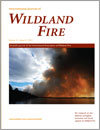International Journal of Wildland Fire
Volume 21
Number 5 2012
This paper presents a proposal for integrating the predominantly biophysical study of fire ecology with social science research in human–environment interactions. Through literature review and case studies from the south-eastern USA and tropical Australia, we discuss how the study of fire ecology can benefit from a more rigorous incorporation of theory from human ecology.
Post-bushfire litigation and non-litigated claims against the New South Wales Rural Fire Service are reviewed to determine the true extent of claims for compensation arising from Australian unplanned wildfires and hazard reduction activities. The effect of litigation is compared with other judicial proceedings such as coroner’s inquests and Royal Commissions.
Climatic, topographic and vegetation factors were analysed for 3337 fires greater than 25 ha in peninsular Spain (1991–2005). Logistic regression, discriminant analysis and regression tree models showed significant relationships between probability of burning and land cover and slope. Fire size class models were related to ecozones and climatic variables.
Distribution patterns of wildfire sizes in Mississippi from 1991 to 2007 were examined by descriptive and extreme value statistics. Wildland fires occurred most frequently between February and May and in the ecoregion of outer coastal plain mixed-forest province. Wildfires in Mississippi followed the generalised Pareto distribution.
Wildland fires caused by lightning are examined for Victoria in south-east Australia. The examination includes fire duration, area burnt, temporal variability in the average chance of fire per lightning stroke, and the time period from lightning ignition until a fire is first observed. Results are compared with other international studies.
To be able to estimate how much water is required for extinguishing a wildfire would be an important tool during fire fighting operations. Using the flame length and size of the active combustion area as indicators, the required amount of water was calculated and validated against fire experiments.
Wildfires have the potential to affect the water chemistry and biological communities of streams. This paper investigates the short-term effects (12 months) of a fire on a saline stream in a semiarid region of Australia. Small increases in nutrients, colour and turbidity and decreases in dissolved oxygen occurred but these returned to pre-fire conditions within 2–3 months. No effect on the macroinvertebrate community was apparent.
Spatial patterning of soil properties is important for the ecology of many semiarid rangelands. Interactions of fire, vegetation and erosion appear to reinforce the spatial patterning of soil properties in sagebrush steppe, a critical semiarid rangeland habitat increasingly affected by wildfire. However, increased fire frequency could decrease ability to withstand change.
Preventing or suppressing fire in a wetland requires consideration of the consequences of fire-management action on water quality. A preliminary investigation of chemical fire retardants on heat treated sediments indicated changes in the soluble nutrient load and buffering the acidity generated by the heating and burning of organic sediment.
This study investigated the effects of grasslands on fire frequency and occurrence within the ponderosa pine-dominated forests of the Colorado Front Range. Owing to proximity to prevalent fine fuels able to support surface fires, stands adjacent to grasslands experienced more frequent fire and a greater response to interannual wet–dry patterns than stands not adjacent to grasslands.
The Malheur model predicts the post-fire mortality probability of ponderosa pine based on crown scorch and bole scorch. The model accurately predicted mortality for 10 109 ponderosa pines from 24 fires and was shown to predict accurately for small trees, large trees (≥53.3‐cm DBH), prescribed fires and wildfires
Validated against field survey data, loads of fine fuels were estimated fairly well by the shadow fraction method using a very high spatial resolution QuickBird satellite image over the Daxinganling Region in China. This estimation outperformed an estimate by a lower spatial resolution Thermatic Mapper image.
Common wildland fire fuels of pine savannas in the south-eastern US Coastal Plain were collected to determine energy content. Measured energy contents were then used in the BehavePlus fire behaviour modelling system to determine the relative advantage of using the newly measured energy contents v. the default value.
This study investigates properties affecting consumption of rotten coarse woody debris during laboratory fire. Three decay classification methods and two ignition strategies were used to simulate a high-intensity short-duration fire and a low-intensity long-duration fire. Rotten debris lost more mass to combustion than did sound debris.
A model system has been developed for estimating the maximum potential spotting distance from an active crown fire as a function of firebrand particle diameter on alighting, based on three simple inputs, namely, canopy-top height, free flame height (i.e. flame distance above the canopy-top height), and the wind speed at the height of the canopy.




